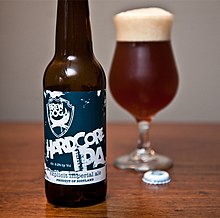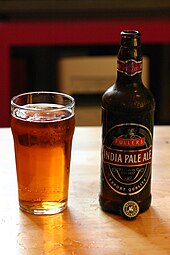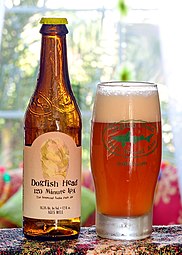India pale ale
| India pale ale | |
|---|---|
 Hardcore IPA from BrewDog | |
| Country of origin | United Kingdom |
| Alcohol by volume | 4.5–20% |
| Original gravity | 1.050–1.090 |
| Final gravity | 1.000–1.025 |
India pale ale (IPA) is a hoppy beer style within the broader category of pale ale.[1][2]
India pale ale was originally an export beer shipped to India, which was under the control of the British East India Company until 1858.[1][2][3][4]
History
[edit]The pale ales of the early 18th century were lightly hopped and quite different from today's pale ales.[5] By the mid-18th century, pale ale was brewed mostly with coke-fired malt, which produced less smoking and roasting of barley in the malting process, and hence produced a paler beer.[6][7] One such variety of beer was October beer, a pale well-hopped brew popular among the landed gentry, who brewed it domestically; once brewed it was intended to cellar two years.[8]
Among the first brewers known to export beer to India was George Hodgson's Bow Brewery,[9] on the Middlesex-Essex boundary. Its beers became popular among East India Company traders' provisions in the late 18th century for being two miles up the Lea from the East India Docks,[a] and Hodgson's liberal credit line of 18 months. Ships exported this beer to India, among them his October beer, which benefited exceptionally from conditions of the voyage and was highly regarded among its consumers in India.[11] The brewery came into the control of Hodgson's son early in the next century,[b]
Burton breweries lost their export market in Continental Europe, including Scandinavia and Russia, when the Napoleonic blockade was imposed, and were seeking a new export market for their beer.[10]

At the behest of the East India Company, Allsopp's brewery's chief maltser, Job Goodhead, developed a strongly-hopped pale ale in the style of Hodgson's for export to India.[12][13] Other Burton brewers, including Bass and Salt and Co, followed Allsopp's lead, taking advantage of Burton water in brewing similar beers.[c]
London East End brewer Charrington's trial shipments of hogsheads of "India Ale" to Madras and Calcutta in 1827 proved successful and a regular trade emerged with the key British agents and retailers: Griffiths & Co in Madras; Adam, Skinner and Co. in Bombay and Bruce, Allen & Co. in Calcutta.[14]
Early IPAs were only slightly higher in alcohol than other beers brewed then, but more of the wort was fermented, meaning few residual sugars, and they were heavily hopped.[15][16] While IPAs were formulated to survive long voyages by sea better than other styles of the time, porter was also successfully shipped to India and California.[17]
By the 1860s, India pale ales were widely brewed in England, and they were much more attenuated and hopped than porters and ales.[18]

Demand for the export style of pale ale, which had become known as "India pale ale", developed in England around 1840 and India pale ale became a popular product in England.[3][4] In 1837, Hodgson's IPA typically cost 6/6 (32.5p; equivalent to £37 in 2023[19]) for a dozen pint bottles, the same as Guinness Double Stout, 53% more than the 4/3 (21.25p; equivalent to £24) a dozen for those of porter.[20] Some brewers dropped the term "India" in the late 19th century, but records indicated that these "pale ales" retained the features of earlier IPAs.[21] American, Australian, and Canadian brewers manufactured beer with the label IPA before 1900, and records suggest that these beers were similar to English IPA of the era.[22][23]
IPA style beers started being exported to other colonial countries, such as Australia and New Zealand, around this time with many breweries dropping the 'I' in 'IPA' and simply calling them Pale Ales or Export Pales. Kirkstall Brewery and many competitors sent much export beer across the world by steam ship to auction off to wholesalers upon arrival.
United Kingdom
[edit]India pale ale was well known as early as 1815,[24] but gained popularity in the British domestic market sometime before then.[24][25] By World War I, IPA in Britain had diverged into two styles, the premium bottled IPAs of around 1.065 specific gravity and cask-conditioned draught IPAs which were among the weakest beers on the bar. For instance Bass was 1.065 OG and 6.4% ABV, but in 1912 Whitbread's draught IPA was 1.049 and less than 5% ABV, at a time when the average British beer was 1.055.[26] Like all British beers, their strength declined during World War I and by 1923 Bass was 1.055[27] and Whitbread IPA was a bottled beer of 1.036 and 3.7% (compared to their standard X Mild at 1.042 and their draught bitter at 1.042).[28] Greene King IPA (3.7%) and Charles Wells Eagle IPA (3.6%) are examples of IPAs in this tradition.
Worthington's White Shield is an example of a historic India Pale Ale, first brewed in 1829 principally for export to the British Empire. By the 1960s White Shield had become a cult drink brewed in small quantities for a dedicated following, but it found renewed popularity in the early 1970s when the demand for real ale grew in the UK.[29][30]
The revival of IPA in modern times dates to a seminar on Burton pale ales organised by publican Mark Dorber at his pub, the White Horse, Parson's Green, in 1990. That led to a pale ale festival in 1992 and an IPA festival in 1993, for which Bass brewed a 7.2% beer inspired by Bass Continental, originally brewed for the Belgian market before World War II and based on Bass recipes going back to the 1850s.[31] Dorber and Roger Protz then organised an IPA conference in 1994 at Whitbread's brewery in London, attended by brewers from both sides of the Atlantic.[32] The influence of this meeting persists, for instance Brooklyn Brewery's East India IPA is based on the beer that Garrett Oliver took there.[32]
In the 21st century, US-influenced IPA is one of the most popular beer styles in the UK.[33] In 2019, Brewdog's Punk IPA was the country's best selling craft beer in the on-trade[34] and Swannay's Muckle IPA won overall craft keg gold in SIBA's Independent Beer Awards.[35]
United States
[edit]
In the late 20th century craft beer revolution in the United States, brewers began seeking out old beer styles that had fallen out of vogue; Ballantine IPA, which had been made in the U.S. since 1890 until the 1990s, proved inspirational.[2] The traditional IPA style was well-suited to model the intense flavour and aroma of American hops.[2] Bert Grant of Yakima Brewing and Malting identified that Cascade and Chinook hops, grown locally in Yakima, Washington, provided strong flavours when showcased in an IPA.[36][2] The boom in popularity for IPA as a style spread down the west coast of the United States, then across the United States and eventually the world. It is estimated that over 40% of craft beer brewed in the United States can be classified as an IPA.[37]
As the Oxford Companion to Beer notes: "IPA is now the signature of craft brewers worldwide. Fittingly for an export beer, brewers from Australia to Scandinavia are creating new beers, mostly inspired by the American take on the style, but often adding a regional twist of their own."[2]
Black IPA
[edit]Black IPA (also known as Cascadian Dark Ale (CDA) or American Black Ale) is not pale in colour. Black IPAs share the bitter hoppy flavours of other IPAs; however, the use of roasted malts gives them a much darker malty flavour. Greg Noonan of Vermont Pub & Brewery created the first black IPA for sale on draught only in the pub in the early 1990s, but it didn't become popular in the United States until 2009.[38]
Brut IPA
[edit]A crisp, dry IPA, the Brut IPA was invented by Kim Sturdavant, head brewer at San Francisco's Social Kitchen and Brewery.[39][40] To make a brut IPA, brewers add the enzyme amyloglucosidase to remove sugars.
Double IPA
[edit]Double IPAs (also referred to as Imperial IPAs) are a stronger, very hoppy variant of IPAs that typically have alcohol content above 7.5% by volume.[41] The term "double" refers to the increased amount of ingredients used, particularly hops, which results in a beer that is both higher in alcohol and richer in the hop character compared to a standard IPA. The style is claimed to have originated with Vinnie Cilurzo, currently[when?] the owner of Russian River Brewing Company in Santa Rosa, California, in 1994 at the now-defunct Blind Pig Brewery in Temecula, California.[42]

New England IPA
[edit]New England IPA (NEIPA, also referred to as Hazy IPA or Juicy IPA or, less frequently, Vermont IPA) was invented by John Kimmich in 2004 at the Alchemist Brewery in Waterbury, Vermont.[43] Characterized by juicy citrus and floral flavours, with an emphasis on hop aroma with lower bitterness, they also have a smooth consistency or mouthfeel, and a hazy appearance. These characteristics are achieved using a combination of brewing techniques, including the use of particular strains of yeast, the timing of adding the hops, and adjusting the chemistry of the water.[44][45][46][47] New England IPAs do not necessarily need to be brewed in New England.[48] It was officially recognized as a separate beer style, the Juicy or Hazy India Pale Ale, by the Brewers Association in 2018.[49][50] A variation on the style is the milkshake IPA, which adds lactose and occasionally fruit to make a New England IPA more creamy.[51]
Triple IPA
[edit]Triple IPAs are characterized by higher hop flavours and higher alcohol content, with alcohol content usually over 10% ABV.
American IPA / West Coast IPA
[edit]Both American and West Coast IPAs are hop-forward in character, with the West Coast variety being especially so.[52] They often have brilliant clarity and are dry with minimal malt character. Being highly hopped, West Coast / American IPAs are typically very bitter, between 40 and 70 IBUs.[53] As such, they commonly taste of resin as well as citrus and tropical fruit from the use of American "C" hops, although these are not the only hops that can be used; often breweries around the world emulating the style will use local New-World hop varieties, or may use a combination of American and local hops.[54]
White IPA
[edit]White IPAs combine the flavours of an American IPA and a Belgian-style wheat beer.[55] Created in collaboration between 2 breweries; Larry Sidor the brewmaster at Oregon-based Deschutes Brewery, and Belgian-born Steven Pauwels, brewmaster at Boulevard Brewing in 2010. [56]
India pale lager / Cold IPA
[edit]India pale lager (IPL) or Cold IPA is a hoppy beer style inspired by India pale ale. But unlike IPAs, IPLs are fermented with a lager yeast strain at lower, and hence, colder lager fermentation temperatures. They generally combine a crisp lager finish with amplified hops.[57][58]
-
Great Divide
Titan IPA -
Bell's
Two Hearted Ale -
Fuller's
India Pale Ale -
Dogfish Head
120 Minute IPA -
Nils Oscar
India Ale -
Nøgne Ø
India Pale Ale
See also
[edit]Explanatory footnotes
[edit]- ^ The Bow Brewery was on the west bank, south of Bow bridge with a wharf opposite.[10]
- ^ Mark Hodgson died in 1810, leaving the Bow Brewery in the care of a trust. His only surviving son, Frederick, took control of the brewery in 1819.[10]
- ^ The water of Burton on Trent contains a very high concentration of sulphate which accentuates the bitterness of beer. See Daniels, Foster, and Cornell.
Citations
[edit]- ^ a b "A history of the authentically global beer". The Economist. ISSN 0013-0613. Retrieved 2020-04-11.
- ^ a b c d e f Oliver, Garrett (2012). The Oxford Companion to Beer. New York: Oxford University Press. p. 485. ISBN 978-0-19-536713-3. OCLC 706025045.
- ^ a b Daniels 1996, p. 155
- ^ a b Cornell 2008, p. 104
- ^ Anonymous 1744, pp. 72–73
- ^ Foster 1999, p. 13
- ^ Daniels 1996, p. 154
- ^ Cornell 2008, pp. 97–98
- ^ "How the India Pale Ale Got Its Name". Smithsonian Magazine. Retrieved 6 November 2017.
- ^ a b c Pryor, Alan (2009). "Indian Pale Ale: an Icon of Empire" (PDF). Commodities of Empire Working Paper (13). ISSN 1756-0098. Retrieved 17 February 2015.
- ^ Cornell 2008, p. 98
- ^ Foster 1999, p. 26
- ^ Cornell 2008, p. 102
- ^ Mathias 1959, p. 190.
- ^ Foster 1999, pp. 17–21 discusses the hopping rate; Daniels 1996, p. 154 discusses the high level of fermentation.
- ^ Foster 1999, p. 21
- ^ "In the Room: The Story of Anchor IPA". Anchor Brewing Blog. Anchor Brewing Company. 14 February 2014. Retrieved 28 April 2014..
- ^ Daniels 1996, p. 156
- ^ UK Retail Price Index inflation figures are based on data from Clark, Gregory (2017). "The Annual RPI and Average Earnings for Britain, 1209 to Present (New Series)". MeasuringWorth. Retrieved May 7, 2024.
- ^ "Wandsworth in the Fields. In thorough." The Times, 15 June 1837, p. 2.
- ^ Foster 1999, p. 65
- ^ Daniels 1996, pp. 157–58
- ^ Cornell 2008, p. 112
- ^ a b Webster, Thomas (1815). An Encyclopæaedia of Domestic Economy. Harper & Brothers. pp. 598, 599.
- ^ "IPA: the executive summary". Zythophile.co.uk. 31 March 2010. Retrieved 6 November 2017.
- ^ Pattinson, Ron (13 February 2016). "English IPA".
- ^ Pattinson, Ron (10 May 2020). "Bass Pale Ale 1851 - 1994".
- ^ Pattinson, Ron (2 March 2009). "Let's Brew 1923 Whitbread IPA!".
- ^ Fort, Matthew (22 September 2007). "Vintage beers". The Guardian. Retrieved 12 April 2020.
- ^ Jackson, Michael (29 August 1992). "Drink the beer, swallow the tonic". The Independent. Retrieved 12 April 2020.
- ^ Boak, Jessica; Bailey, Ray (7 May 2020). "What do we really know about how to brew Bass?".
- ^ a b Protz, Roger (14 November 2016). "Taste the IPA that launched the revival".
- ^ Moyle, Nick; Hood, Richard (27 September 2017). "10 best IPAs". Independent. Retrieved 2020-05-23.
- ^ Stone, Stuart (26 November 2019). "BrewDog Punk IPA sales increase by 19.7%". Morning Advertiser. Retrieved 2020-05-23.
- ^ Society of Independent Brewers. Gloucester, Swannay, and Wibblers Brewery take overall UK Gold. Retrieved 23 May 2020
- ^ Messer, Ryan (23 June 2017). "Bert Grant: The Godfather of Craft Brewing". Yakima Herald-Republic. Retrieved 2020-04-11.
- ^ "The IPA is dead, long live the IPA: Why the love-it-or-hate-it beer is here to stay". Salon. 2022-04-26. Retrieved 2022-08-09.
- ^ "Let's Talk Beer Styles: Black IPA". pastemagazine.com. 2016-04-20. Retrieved 2020-04-12.
- ^ Fabricant, Florence (2018-12-21). "Meet Brut I.P.A." The New York Times. ISSN 0362-4331. Retrieved 2020-04-12.
- ^ "The Birth of the Brut IPA". Craft Beer & Brewing. Retrieved 2020-04-12.
- ^ "American Double IPA" Archived 2014-12-07 at the Wayback Machine Beer Advocate. Retrieved 30 May 2013.
- ^ Hieronymus, Stan (2013-01-14). "Hold it, which Blind Pig beer was one of the first Double IPAs?". Appellation Beer. Retrieved 2022-10-21.
- ^ "The 'Haze Craze': Beer Lovers' Newfound Obsession With Murky IPAs". NPR.org. Retrieved 2020-04-12.
- ^ Alström, Jason; Alström, Todd (May 2017). "It's Official: New England India Pale Ale Is a Style". Beer Advocate. Retrieved 6 November 2017.
- ^ Noel, Josh (5 July 2017). "How I learned to stop worrying and love hazy IPA — some hazy IPA". Chicago Tribune. Retrieved 25 November 2017.
- ^ Moorhead, John (August 2016). "New England IPA: The Haze Craze". American Homebrewers Association. Retrieved 25 November 2017.
- ^ Sparhawk, Andy (2 August 2017). "The New England Style IPA Is the Anti-IPA". CraftBeer.com. Retrieved 25 November 2017.
- ^ Stein, Jason (8 June 2017). "The Haze Craze: 11 Breweries Outside of New England Making NE IPAs". Paste Magazine. Archived from the original on 27 December 2019. Retrieved 25 November 2017.
- ^ "New England-Style, Hazy Ales Finally Get Industry Recognition". 20 March 2018.
- ^ "Brewers Association Beer Style Guidelines". Brewers Association.
- ^ "What Exactly Is a Milkshake IPA? • Hop Culture". Hop Culture. 2020-01-20. Retrieved 2020-04-12.
- ^ "Your guide to 5 IPAs: Decoding the different styles of this hop-intensive beer". Los Angeles Times. 2014-02-22. Retrieved 2020-04-12.
- ^ "Beer Judge Certification Program". www.bjcp.org. Retrieved 2023-09-15.
- ^ "Beer Judge Certification Program". www.bjcp.org. Retrieved 2023-07-12.
- ^ What is White IPA?, The Manual
- ^ "White IPA: The Beer Born from a Brainstorming Session". 4 November 2015.
- ^ Bernot, Kate (10 March 2016). "What the hell's an IPL?". Draft Magazine. Archived from the original on 8 November 2020. Retrieved 25 November 2017.
- ^ Colby, Chris (4 April 2014). "India Pale Lager". Beer & Wine Journal. Archived from the original on 20 May 2022. Retrieved 25 November 2017.
References
[edit]- Anonymous (1744). The London and Country Brewer. London: Thomas Astley. OCLC 22476249. OL 24190346M.
- Cornell, Martyn (2008). Amber, Gold & Black: The Story of Britain's Great Beers. Zythography Press.
- Daniels, Ray (1996). Designing Great Beers: The Ultimate Guide to Brewing Classic Beer Styles. Brewers Publications. ISBN 978-0-937381-50-2.
- Foster, Terry (1999). Pale Ale: History, Brewing Techniques, Recipes (Second ed.). Brewers Publications. ISBN 978-0-937381-69-4.
- Jackson, Michael (1978). The World Guide to Beer. New York: Ballantine Books. ISBN 978-0-345-27408-3.
- Mathias, Peter (1959). The Brewing Industry in England 1700-1830. CUP Archive. GGKEY:DYD5N29F6JD.
Further reading
[edit]- Brown, Pete (2009), Hops & Glory: One Man's Search for the Beer That Built the British Empire, Pan Macmillan
- "Oregon Brewers Played an Outsized Role in Popularizing IPA". All Things Considered. NPR. 1 June 2024. Retrieved 1 June 2024.
- Steele, Mitch (2012). IPA: Brewing Techniques, Recipes, and the Evolution of India Pale Ale. Brewers Publications. ISBN 978-1-938469-00-8.
External links
[edit] Media related to India Pale Ales at Wikimedia Commons
Media related to India Pale Ales at Wikimedia Commons







